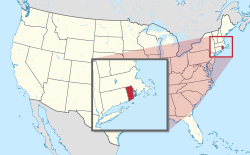William Whalley Homestead | |
 (2021) | |
| Location | 33 Burchard Avenue, Little Compton, Rhode Island |
|---|---|
| Coordinates | 41°32′37″N71°10′9″W / 41.54361°N 71.16917°W |
| Area | 2.1 acres (0.85 ha) |
| Architectural style | Federal |
| NRHP reference No. | 88001127 [1] |
| Added to NRHP | August 3, 1988 |
The William Whalley Homestead is an historic farmstead in Little Compton, Rhode Island. The main house is a 1+1⁄2-story wood-frame structure, probably built sometime between 1815 and 1830. The property includes a late 19th century gabled barn and a stone and wood outbuilding, and is bounded by a low stone wall. The main house is a fairly typical Cape style house, five bays wide, with a central chimney. The property as a whole is a well-preserved example of a typical 19th-century farmstead in the area. [2]
Contents
The homestead was listed on the National Historic Register in 1988. [1]


